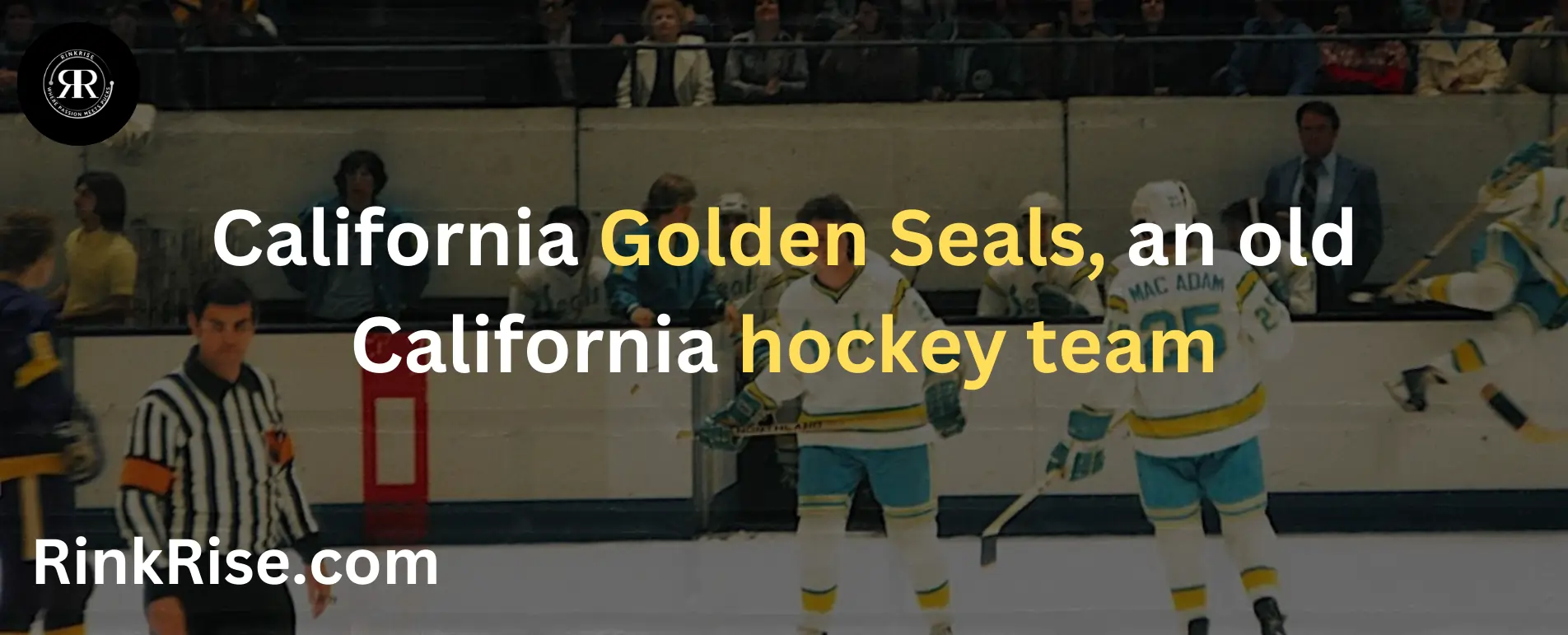introduction to the California Golden Seals
The California Golden Seals were an ice hockey team in the National Hockey League (NHL) from 1967 to 1976. Originally named the “California Seals,” the team underwent a name change to “Oakland Seals” during the 1967–68 NHL season before finally adopting the name California Golden Seals in 1970.
This team was part of a significant expansion in 1967 that introduced six new teams to the NHL. The Seals played their home games at the Oakland-Alameda County Coliseum Arena in Oakland, California. Despite their efforts, the team struggled to attract a strong fan base, leading to their relocation to Cleveland, Ohio, where they became the Cleveland Barons in 1976.
Formation of the Oakland Seals
In 1966, the NHL announced the addition of six new teams, including the San Francisco Seals, to counter the Western Hockey League’s growth and extend the league’s reach. Barry Van Gerbig acquired the WHL’s San Francisco Seals with plans to transition them into the NHL for the 1967-68 season, initially aiming to play in a new San Francisco arena.
However, when the arena plans fell through, he relocated the team to Oakland, rebranding them as the California Seals to attract a broader fan base and establish Oakland as a major league city.
Despite initial popularity while playing in Daly City’s Cow Palace, the team’s fan base dwindled after the move to Oakland. On November 6, 1967, Barry attempted to solidify their presence by renaming them the Oakland Seals, a change officially registered by the league in December. Despite these efforts, the team struggled to attract fans in Oakland, indicating the relocation did not successfully bridge the fan gap from San Francisco.
Challenges Faced by the Team
The California Seals faced ongoing struggles with low attendance and threats of relocation. In their first year, proposals to move the team to Vancouver or Buffalo were rejected by the NHL, even though both cities joined the league in the 1970 expansion. The Knox brothers, who briefly owned a part of the Seals, sold their share to start the Buffalo Sabres.
Due to poor performance, the Seals saw significant turnover in management and roster, with only seven of the original 20 players remaining after the first season. These changes led to slight improvements, resulting in the team making the playoffs twice, although they continued to have losing seasons.
The NHL’s refusal to allow the Seals’ relocation to Vancouver prompted a lawsuit, San Francisco Seals Ltd. v. National Hockey League, which was settled in 1974. The court ruled that the NHL’s relocation restrictions were lawful as the league operated as a single entity.
In the 1969-1970 season, the team was acquired by Trans National Communications, which included well-known investors but went bankrupt shortly after, leading to the team reverting to its previous owner, who then put it up for sale again.
Acquisition of the NHL Franchise by Charles O. Finley
Before the 1970-71 NHL season, Charles O. Finley, owner of the Oakland Athletics, bought the Seals. Although Jerry Seltzer had a competitive bid, NHL owners preferred Finley’s proposal.
Mid-season, conflicts with Finley led to General Manager Bill Torrey’s departure. Shortly after the season began, Finley rebranded the team as the California Golden Seals, changing their colors to green and gold, aligning with the Athletics, and introduced new marketing strategies, including a redesigned logo and team imagery.
Despite these efforts, the team finished with the lowest standing in the league. A significant trade at the end of the season saw the Seals give up a valuable draft pick for Montreal’s first-round pick in 1970, Ernie Hicke, and cash. This allowed Montreal to draft future Hall of Famer Guy Lafleur, resulting in one of the most disproportionate trades in NHL history.
Ownership and Management of an NHL Team
In the 1971-72 season, the California Seals experienced brief improvements, but the rise of the World Hockey Association (WHA) led to the departure of five of their top scorers, significantly weakening the team.
The Seals struggled defensively, except for standout goaltender Gilles Meloche, and consistently finished last in their division. Despite a divisional realignment in 1974, they were unable to compete effectively against strong teams like Buffalo, Boston, and Toronto.
Owner Charles Finley, frustrated by the team’s poor performance, attempted to sell the Seals, but no successful deals materialized. The NHL took over ownership in February 1974, purchasing the team for $6.585 million.
Efforts by Finley to sell and relocate the team were blocked by the NHL. Plans for relocation to Denver and Seattle in 1975 fell through, leading to the NHL’s continued management of the Seals.
The team was eventually bought by Melvin Swig in 1975, who planned to move them to a new arena in San Francisco. However, after a change in the mayoral office and the subsequent scrapping of the new arena plans, the NHL withdrew its opposition to relocating the team, allowing for potential moves to address the ongoing challenges.
Read more: Mapping Hockey in California: Teams in NHL, AHL, ECHL, WSHL, and NCAA
The Closure of the California Golden Seals
Despite some improvement in attendance and on-field performance, minority owners George and Gordon Gund convinced Swig to request approval to relocate the team to Cleveland, their hometown.
The league sanctioned the relocation on July 14, 1976, renaming the team as the Cleveland Barons, reminiscent of the city’s former AHL team.
Despite their efforts, the Barons faced continuing losses and dwindling attendance. By this time, the Gunds had become majority owners and were allowed to merge the Barons with another struggling team, the Minnesota North Stars, on June 15, 1978.
The merged entity proceeded as the Minnesota North Stars, maintaining ownership under the Gunds but taking the Barons’ spot in the Adams Division.
The North Stars moved to Texas after the 1992-93 NHL season to become the Dallas Stars.
The Cleveland Barons are noted as the last franchise in a major North American professional sports league to cease operations and the only NHL team to do so since 1942.
Following these changes, the NHL featured 17 teams in the 1978-79 season.
Bay Area Hockey Evolution
The San Jose Sharks are deeply rooted in the history of Bay Area hockey, tracing back to the Seals. The desire to revive hockey in this region was fueled by the Gunds following the merger between the Barons and the North Stars. Although initially they sought to relocate the North Stars to the Bay Area during the late 1980s, the NHL was reluctant to leave a well-established hockey market like the Twin Cities.
Concurrently, an initiative led by Howard Baldwin, the former owner of the Hartford Whalers, advocated for a new NHL team in San Jose, coinciding with the construction of a new arena there. This led to a settlement where the Gunds would sell their interest in the North Stars to Baldwin’s group and in exchange, obtain an expansion team for the Bay Area that would start competing in the 1991-92 season.
This arrangement also granted the Sharks access to players from the North Stars and allowed them to participate in an expansion draft with the new franchise as equals. Officially, on May 5, 1990, the Gunds sold their share of the North Stars to Baldwin and were granted the new Bay Area team, which was named the Sharks.
Interestingly, the Sharks’ initial seasons in the NHL were played at the Cow Palace in Daly City, the same venue the NHL had earlier deemed unsuitable for the Seals in 1967, while their permanent arena in San Jose was being finalized.
Dennis Maruk, the last active NHL player from the Seals, retired in 1989 as a member of the North Stars. The final former Seals player in any professional league was Charlie Simmer, who played with the IHL’s San Diego Gulls until 1992.
Team Performance Highlights
Career Achievements
- Most appearances: Bob Stewart (414)
- Top scorer: Dennis Maruk (94 goals)
- Highest assists: Al MacAdam (129)
- Leading points scorer: Al MacAdam (217)
- Most penalty minutes: Bob Stewart (691)
- Greatest number of wins by a goalie: Gilles Meloche (93)
- Most games lost by a goalie: Gilles Meloche (191)
- Best goals-against average by a goalie: Charlie Hodge (3.09)
- Most shutouts by a goalie: Gilles Meloche (11)
- Most playing time: Gilles Meloche (20,666 minutes)
- Most victorious coach: Fred Glover (96 wins)
- Coach with most losses: Fred Glover (206)
Seasonal Records
- Most goals in a season: Dennis Maruk (36 in 1977-1978)
- Most assists in a season: Dennis Maruk (50 in 1976-1977)
- Highest points in a season: Dennis Maruk (78 in 1976-1977)
- Most wins in a season by a goalie: Gary Smith (21 in 1968-1969)
- Most losses in a season by a goalie: Gary Smith (48 in 1970-1971)
- Lowest goals-against average in a season by a goalie: Charlie Hodge (2.86 in 1967-1968)
- Most shutouts in a season by a goalie: Gary Smith and Gilles Meloche (4 each in different seasons)
Prominent Figures
Hall of Fame Inductees
- Harry Howell
- Bert Olmstead
- Craig Patrick
- Rudy Pilous
- Bill Torrey
Team Leadership
- Bobby Baun (1967–1968)
- Ted Hampson (1968–1971)
- Carol Vadnais (1971–1972)
- Bert Marshall (1972–1973)
- Joey Johnston (1974–1975)
- Jim Neilson and Bob Stewart (1975–1976, co-captains)
Key Draft Selections
- 1967: Ken Hicks (third overall)
- 1969: Tony Featherstone (seventh overall)
- 1970: Chris Oddleifson (10th overall)
- 1974: Rick Hampton (third overall)
- 1975: Ralph Klassen (third overall)
Executive Management
- Rudy Pilous, 1967 (dismissed before the season began)
- Bert Olmstead (1967–1968, stepped down in March 1968)
- Frank Selke Jr. (1968–1970, stepped down in November 1970)
- Bill Torrey, (1970, stepped down in December 1970)
- Fred Glover (1970–1971, dismissed in October 1971)
- Garry Young (1971–1972, dismissed in November 1972)
- Fred Glover (1972–1974, stepped down in February 1974)
- Garry Young (1974, appointed as Director of Hockey Operations; stepped down before the 1974–75 season)
- Bill McCreary (1974–1976, started as Director of Hockey Operations and was promoted to general manager in summer 1975 after Melvin Swig purchased the team from the league)
Key Facts About the California Golden Seals
Notable Achievements and Players
The Golden Seals (1971–1973) featured Bernie Parent, a future Hall of Fame goalie, who became a fan favorite with his exceptional skills, despite the team never reaching the Stanley Cup Finals.
Iconic Uniform Changes
The team underwent several uniform transformations, starting with a primarily black and gold palette before switching to a memorable teal and orange combo, making their gear some of the most iconic in NHL history.
Team Relocation and Renaming
Due to financial challenges, the Golden Seals relocated to Cleveland in 1976 and were renamed the Cleveland Barons. The Barons only lasted for two seasons before being dissolved.
Contribution to California Hockey
Although their time in the NHL was short, the Golden Seals laid the foundation for future California hockey teams, including the inception of the Los Angeles Kings in 1967 and the San Jose Sharks in 1991.
Dedicated Fanbase
The Golden Seals maintained a devoted fan base in the Bay Area, known for their enthusiastic support despite the team’s performance challenges, earning the nickname the “Seals Army.”
Also read: What Are The 4 NHL Teams In California?
Final Thoughts
Despite never capturing the Stanley Cup, the story of the California Golden Seals offers a fascinating glimpse into the early expansion era of the NHL. Their unique uniforms, dedicated fan base, and the presence of eventual Hall of Famers like Bernie Parent have firmly established their place in the history of hockey in California. This summary highlights the team’s cultural and historical impact within the sport.
FAQ’s: California Golden Seals:
The California Golden Seals moved, but why?
The main drivers behind the team’s relocation to Cleveland were budgetary constraints and low attendance.
Did any Golden Seals players win the Stanley Cup?
Bernie Parent won the Stanley Cup with the Philadelphia Flyers in 1974 and 1975, after he left the Golden Seals.
Are the California Golden Seals connected to the San Jose Sharks?
Not directly. However, the Golden Seals helped lay the groundwork for hockey’s popularity in California, which likely contributed to the success of the San Jose Sharks.
Can I watch today’s California Golden Seals game?
A: Regretfully, there is no longer a California Golden Seal. The franchise moved before going out of business in 1978.
Where can I find out more information on Golden Seals in California?
A: Information on the California Golden Seals may be found on several websites, local sports museums in the San Francisco Bay Area, online fan forums, and websites that chronicle hockey history.




It is advisable to tie one Mauli-rakhi together with the principle rakhi on the wrist of brother as an emblem of protection from evil and bad spirits.
Hello. Very nice web site!! Man .. Excellent .. Superb .. I will bookmark your site and take the feeds also…I am satisfied to locate so much useful information here in the post. Thanks for sharing.
I am glad to be a visitant of this perfect blog, regards for this rare info!
Considerably, the post is in reality the finest on that laudable topic. I fit in with your conclusions and can eagerly look forward to your incoming updates. Saying thanks definitely will not simply just be enough, for the outstanding clarity in your writing. I will certainly at once grab your rss feed to stay privy of any kind of updates. Pleasant work and also much success in your business efforts!
There is definately a great deal to learn about this topic. I really like all of the points you made.|
Aw, this was an extremely nice post. Spending some time and actual effort to generate a really good article… but what can I say… I hesitate a lot and never manage to get nearly anything done.